Statistical Modeling of Traffic Flow in Commercial Clusters Based on a Street Network
Abstract
:1. Introduction
2. Research Methods
2.1. Research Unit
2.2. Data
3. Results
3.1. Descriptive Statistics Analysis
3.2. Construct Mode
3.2.1. Correlation Analyses
3.2.2. Multiple Regression
4. Discussion
5. Conclusions
- (1)
- The traffic flow of commercial clusters can be predicted using the following method: the study objectives are classified and matched according to the classification results in order to construct multiple regression models for the prediction using three easily accessible metrics: integration (Dn), the traffic class, and the operation cycle (Table 4).
- (2)
- Compared with the average depth, accessibility, and connectivity, global integration is more strongly correlated with traffic flow, while global integration shows a positive correlation with traffic flow.
- (3)
- Based on the comparison of street network connectivity indexes, the urban location conditions of the three types of commercial clusters are comparable, the semi-grid and grid types have better traffic accessibility, and the radiation energy of commercial vitality is better than that of the tree clusters. Moreover, it is easier to establish the spatial orientation of the customer flow.
Author Contributions
Funding
Data Availability Statement
Acknowledgments
Conflicts of Interest
Appendix A
| Commercial Cluster | Forms | |
|---|---|---|
| 1 | Shanghai Jinsu Shichang | Semilattice |
| 2 | Zhangjiagang Jonglong yuan | Lattice |
| 3 | Changshu Fuzhuang Cheng | Semilattice |
| 4 | Suzhou Sichou Cheng | Lattice |
| 5 | Binzhou Heibai Tei cheng | Semilattice |
| 6 | Yiwu Guoji Shangmao | Tree |
| 7 | Suzhou Huagong Jiaoyi Zhongxin | Lattice |
| 8 | Dalian Shiyou Jiaoyi Suo | Tree |
| 9 | Shaoxin Qingfang Cheng | Tree |
| 10 | Baoding Baigou Cheng | Lattice |
| 11 | Tianjin Xiyou Jinshu Shichang | Tree |
| 12 | Nantong Zhihao Shichang | Lattice |
| 13 | Chengduo Guoji Shangmao | Tree |
| 14 | Jinhua Keji Wujin Jituan | Lattice |
| 15 | Taian Gangcai Shichang | Semilattice |
| 16 | Ningbo Suliao Cheng | Semilattice |
| 17 | Beijing Xingfa Zhongxin | Semilattice |
| 18 | Shanghai Shihua Jiaoyi Zhongxin | Semilattice |
| 19 | Wuxi Dongfang Gangcai Cheng | Lattice |
| 20 | Shijiazhuang Xinhua Shangmao | Semilattice |
| 21 | Nantong Guoji Jiafang Cheng | Tree |
| 22 | Shanxin Qingfang Cheng | Lattice |
| 23 | Wuxi Gangkou Wuliu Yuan | Semilattice |
| 24 | Anshan Xiliu Fuzhuang Cheng | Lattice |
| 25 | Zhengzhou Guoji Nongye Zhongxin | Tree |
| 26 | Beijing Ershou Qiche Shichang | Lattice |
| 27 | Wuxi Jinsu Cailiao Shichang | Semilattice |
| 28 | Tianjin Zhongchu Fazhan Shichang | Tree |
| 29 | Shenyan Wuai Shangpin Shichang | Semilattice |
| 30 | Wuxi Nanfang Buxiugang Shichang | Lattice |
| 31 | Shijiazhuang Santiao Shichang | Semilattice |
| 32 | Hefei Huishang Gangcai Shichang | Lattice |
| 33 | Hangzhou Jinshu Cailiao Shichang | Semilattice |
| 34 | Yuncheng Yudu Shichang | Semilattice |
| 35 | Shanghai Shiyou Jiaoyi Gongsi | Semilattice |
| 36 | Linyi Wangbao Gangcai Shichang | Semilattice |
| 37 | Huanan Kuangwu Wuliu Shichang | Lattice |
| 38 | Wuxi Huadong Shihua Shichang | Tree |
| 39 | Zhenjiang Guoji Gangtie Zhongxin | Lattice |
| 40 | Suzhou Fangzhi Yuanliao Shichang | Semilattice |
| 41 | Chongqin Chaotianmen Shichang | Tree |
| 42 | Dalian Shangpin Cheng | Semilattice |
| 43 | Tianjin Konggang Qiche Shichang | Lattice |
| 44 | Shanxin Qingfang Gongmao Yuan | Lattice |
| 45 | Nanchang Hongcheng Shichang | Lattice |
| 46 | Changsha Gaoqiao Shichang | Lattice |
| 47 | Nanjing Zhongcai Nongye Shichang | Lattice |
| 48 | Anqing Guangcai Shichang | Lattice |
| 49 | Langfang Xianghe Jiaju Cheng | Tree |
| 50 | Haozhou Zhongyao Jiaoyi Zhongxin | Lattice |
| 51 | Changsha Hongxin Nongye Shichang | Lattice |
| 52 | Beijing Nongfu Changpin Shichang | Lattice |
| 53 | Xuchang Xinqu Gangcai Shichang | Semilattice |
| 54 | Chanzhou Lingjiatang Shichang | Lattice |
| 55 | Guangzhou Zhongda Shichang | Semilattice |
| 56 | Hangzhou Xiaoshan Shangye Cheng | Semilattice |
| 57 | Wuxi Zhaoshang Chengshi Shichang | Lattice |
| 58 | Changsha Gangtie Shichang | Lattice |
| 59 | Fuzhou Nanfang Gangcai Zhongxin | Tree |
| 60 | Changzhou Fangzhi Touzhi Zhongxin | Lattice |
| 61 | Guangzhou Guocai Pifa Shichang | Lattice |
| 62 | Chongqin Guangyinqiao Nongmao | Semilattice |
| 63 | Hangzhou Chengbei Jinshu Shichang | Semilattice |
| 64 | Xingjiang Hengyuan Wuliu Yuan | Tree |
| 65 | Foshan Xiqiao Qingfang Cheng | Semilattice |
| 66 | Changsha Sanxiang Nanhu Shichang | Semilattice |
| 67 | Beijing Jingxiu Nongye Shichang | Semilattice |
| 68 | Liuzhou Shengchang Zhiliao Shichang | Lattice |
| 69 | Guangzhou Yuzhu Jiancai Cheng | Lattice |
| 70 | Qingdao Shucai Pifa Shichang | Semilattice |
| 71 | Shangqiu Nongchangpin Zhongxin | Tree |
| 72 | Suzhou Nanhuan Shichang | Lattice |
| 73 | Wuxi Guolian Jinsu Cailiao Shichang | Tree |
| 74 | Tongxiang Yangmao Shichang | Semilattice |
| 75 | Liaocheng Dadong Gangguang Shichang | Lattice |
| 76 | Shenzhen Haiji Nongmao Shichang | Lattice |
| 77 | Ningbo Meitang Jiaoyi Shichang | Semilattice |
| 78 | Beijing Chengbei Shangpin Shichang | Lattice |
| 79 | LuoYang Guanlin Shichang | Tree |
| 80 | Xuzhou Bali Gangtie Shichang | Semilattice |
| 81 | Chongqin Julong Gangcai Shichang | Lattice |
| 82 | Wuhan Baisha Nongmao Shichang | Lattice |
| 83 | Kunming Luoshi Guoji Cheng | Tree |
| 84 | Shanghai Changqiao Gangcai Shichang | Semilattice |
| 85 | Shenzhen Huanan Cheng | Lattice |
| 86 | Shanghai Gaoqiao Zhongbiao Zhongxin | Tree |
| 87 | Ningbo Haiye Huagong Shichang | Semilattice |
| 88 | Chongqin Lengchu Wuliu Zhongxin | Lattice |
| 89 | Hefei Zhougu Du Nongmao Zhongxin | Lattice |
| 90 | Tianjin Wangding Pifa Shichang | Lattice |
| 91 | Jimo Fuzhuang Pifa Shichang | Tree |
| 92 | Fuzhou Haixia Changpin Shichang | Lattice |
| 93 | Xinjiang Jiuding Shenghe Shichang | Semilattice |
| 94 | Guanghou Shengdi Pige cheng | Lattice |
| 95 | Yantai Sanzhan Shichang | Semilattice |
| 96 | Xuzhou Xuanwu Jituan Shichang | Semilattice |
| 97 | Changsha Zhongnan Qiche Zhongxin | Lattice |
| 98 | Changzhou Suliao Huagong Shichang | Tree |
| 99 | Huzhou Jili Tongzhuang Shichang | Lattice |
| 100 | Hangzhou Fangzhi Caigou Cheng | Lattice |
Appendix B

References
- Nanditha, A.; Sanjay Kumar, V. Development of trip attraction models for the core area of thiruvananthapuram city. In Recent Advances in Civil Engineering; Springer: Berlin/Heidelberg, Germany, 2023; pp. 659–669. [Google Scholar]
- Wu, C.; Ye, Y.; Gao, F.; Ye, X. Using street view images to examine the association between human perceptions of locale and urban vitality in Shenzhen, China. Sustain. Cities Soc. 2023, 88, 104291. [Google Scholar] [CrossRef]
- Lin, J.; Zhuang, Y.; Zhao, Y.; Li, H.; He, X.; Lu, S. Measuring the non-linear relationship between three-dimensional built environment and urban vitality based on a random forest model. Int. J. Environ. Res. Public Health 2023, 20, 734. [Google Scholar] [CrossRef] [PubMed]
- Tang, S.; Ta, N. How the built environment affects the spatiotemporal pattern of urban vitality: A comparison among different urban functional areas. Comput. Urban Sci. 2022, 2, 39. [Google Scholar] [CrossRef] [PubMed]
- Xu, G.; Su, J.; Xia, C.; Li, X.; Xiao, R. Spatial mismatches between nighttime light intensity and building morphology in Shanghai, china. Sustain. Cities Soc. 2022, 81, 103851. [Google Scholar] [CrossRef]
- Pascucci, F.; Nardi, L.; Marinelli, L.; Paolanti, M.; Frontoni, E.; Gregori, G.L. Combining sell-out data with shopper behaviour data for category performance measurement: The role of category conversion power. J. Retail. Consum. Serv. 2022, 65, 102880. [Google Scholar] [CrossRef]
- Formánek, T.; Sokol, O. Location effects: Geo-spatial and socio-demographic determinants of sales dynamics in brick-and-mortar retail stores. J. Retail. Consum. Serv. 2022, 66, 102902. [Google Scholar] [CrossRef]
- Brown, M.J.; Scott, D.M.; Páez, A. A spatial modeling approach to estimating bike share traffic volume from gps data. Sustain. Cities Soc. 2022, 76, 103401. [Google Scholar] [CrossRef]
- Khattak, K.S.; Minallah, N.; Khan, Z.H.; Khan, M.A.; Khan, A.N.; Ayaz, S. Sensing technologies for traffic flow characterization: From heterogeneous traffic perspective. J. Appl. Eng. Sci. 2022, 20, 29–40. [Google Scholar]
- Singh, S.; Santhakumar, S.M. Platoon-based impact assessment of heavy-duty vehicles on traffic stream characteristics of highway lanes under mixed traffic environment. Int. J. Intell. Transp. Syst. Res. 2022, 20, 29–45. [Google Scholar] [CrossRef]
- Zhuang, W.; Cao, Y. Short-term traffic flow prediction based on cnn-bilstm with multicomponent information. Appl. Sci. 2022, 12, 8714. [Google Scholar] [CrossRef]
- Kuchkarov, T.; Hamzayev, J.; Allamuratova, Z. Tracking the Flow of Motor Vehicles on the Roads with Yolov5 and Deepsort Algorithms; Bguir: Minsk, Republic of Belarus, 2022. [Google Scholar]
- Cao, S.; Wu, L.; Wu, J.; Wu, D.; Li, Q. A spatio-temporal sequence-to-sequence network for traffic flow prediction. Inf. Sci. 2022, 610, 185–203. [Google Scholar] [CrossRef]
- Zhang, Y.; Cheng, Q.; Liu, Y.; Liu, Z. Full-scale spatio-temporal traffic flow estimation for city-wide networks: A transfer learning based approach. Transp. B Transp. Dyn. 2022, 1–27. [Google Scholar] [CrossRef]
- Wang, P.; Zhang, Y.; Hu, T.; Zhang, T. Urban traffic flow prediction: A dynamic temporal graph network considering missing values. Int. J. Geogr. Inf. Sci. 2022, 1–28. [Google Scholar] [CrossRef]
- Dong, Y.; Xu, J.; Liu, X.; Gao, C.; Ru, H.; Duan, Z. Carbon emissions and expressway traffic flow patterns in China. Sustainability 2019, 11, 2824. [Google Scholar] [CrossRef] [Green Version]
- Yao, Z.; Wang, Y.; Liu, B.; Zhao, B.; Jiang, Y. Fuel consumption and transportation emissions evaluation of mixed traffic flow with connected automated vehicles and human-driven vehicles on expressway. Energy 2021, 230, 120766. [Google Scholar] [CrossRef]
- Yang, J.; Han, Y.; Wang, Y.; Jiang, B.; Lv, Z.; Song, H. Optimization of real-time traffic network assignment based on iot data using dbn and clustering model in smart city. Future Gener. Comput. Syst. 2020, 108, 976–986. [Google Scholar] [CrossRef]
- Li, S. One-way traffic organization optimization method of microcirculation road network in handan city. In Advances in Urban Engineering and Management Science Volume 1; CRC Press: Boca Raton, FL, USA, 2023; pp. 637–643. [Google Scholar]
- Prakash, C.; Navandar, Y.V.; Golakiya, H.D.; Dhamaniya, A. Analysis of the impact of pedestrian crossing activity on the traffic characteristics at urban midblock sections using simulation technique. In Recent Advances in Transportation Systems Engineering and Management; Springer: Berlin/Heidelberg, Germany, 2023; pp. 569–584. [Google Scholar]
- Wang, M.; Chen, Z.; Mu, L.; Zhang, X. Road network structure and ride-sharing accessibility: A network science perspective. Comput. Environ. Urban Syst. 2020, 80, 101430. [Google Scholar] [CrossRef]
- Jayasinghe, A.; Sano, K.; Abenayake, C.C.; Mahanama, P. A novel approach to model traffic on road segments of large-scale urban road networks. MethodsX 2019, 6, 1147–1163. [Google Scholar] [CrossRef]
- Al-Saaidy, H.J.; Alobaydi, D. Studying street centrality and human density in different urban forms in Baghdad, Iraq. Ain Shams Eng. J. 2021, 12, 1111–1121. [Google Scholar] [CrossRef]
- Sharifi, A. Resilient urban forms: A review of literature on streets and street networks. Build. Environ. 2019, 147, 171–187. [Google Scholar] [CrossRef]
- Huang, B.-X.; Chiou, S.-C.; Li, W.-Y. Accessibility and street network characteristics of urban public facility spaces: Equity research on parks in fuzhou city based on gis and space syntax model. Sustainability 2020, 12, 3618. [Google Scholar] [CrossRef]
- Yao, Y.; Shi, W.; Zhang, A.; Liu, Z.; Luo, S. Examining the diffusion of coronavirus disease 2019 cases in a metropolis: A space syntax approach. Int. J. Health Geogr. 2021, 20, 17. [Google Scholar] [CrossRef] [PubMed]
- Xu, Y.; Rollo, J.; Jones, D.S.; Esteban, Y.; Tong, H.; Mu, Q. Towards sustainable heritage tourism: A space syntax-based analysis method to improve tourists’ spatial cognition in chinese historic districts. Buildings 2020, 10, 29. [Google Scholar] [CrossRef] [Green Version]
- Yang, C.; Qian, Z. Street network or functional attractors? Capturing pedestrian movement patterns and urban form with the integration of space syntax and MCDA. Urban Des. Int. 2022, 1–16. [Google Scholar] [CrossRef]
- Cooper, C.H.; Chiaradia, A.J. Sdna: 3-d spatial network analysis for gis, cad, command line & python. SoftwareX 2020, 12, 100525. [Google Scholar]
- Zhang, L.; Chiaradia, A. How to design the metro network for maximal accessibility potential? A comparative analysis of shanghai. In 24th ISUF International Conference, Valencia, Spain, 27–29 Spetember 2017; Book of Papers; Editorial Universitat Politècnica de València: Valencia, Spain, 2018; pp. 1223–1231. [Google Scholar]
- Zhang, L.; Chiaradia, A.; Zhuang, Y. A configurational accessibility study of road and metro network in Shanghai, China. In Recent Developments in Chinese Urban Planning; Springer: Berlin/Heidelberg, Germany, 2015; pp. 219–245. [Google Scholar]
- Alexander, C. A city is not a tree. In The Urban Design Reader; Routledge: Abingdon, UK, 2013; pp. 172–186. [Google Scholar]
- Ministry of Housing and Urban-Rural Development of the People’s Republic of China. Code for Transport Planning on Urban Road; Ministry of Housing and Urban-Rural Development of the People’s Republic of China: Beijing, China, 1995.
- Chang, D.; Penn, A. Integrated multilevel circulation in dense urban areas: The effect of multiple interacting constraints on the use of complex urban areas. Environ. Plan. B Plan. Des. 1998, 25, 507–538. [Google Scholar] [CrossRef] [Green Version]
- Wu, Z.; Huang, M.; Zhao, A. In Urban traffic planning and traffic flow prediction based on ulchis gravity model and dijkstra algorithm. J. Phys. Conf. Ser. 2021, 1972, 012080. [Google Scholar] [CrossRef]

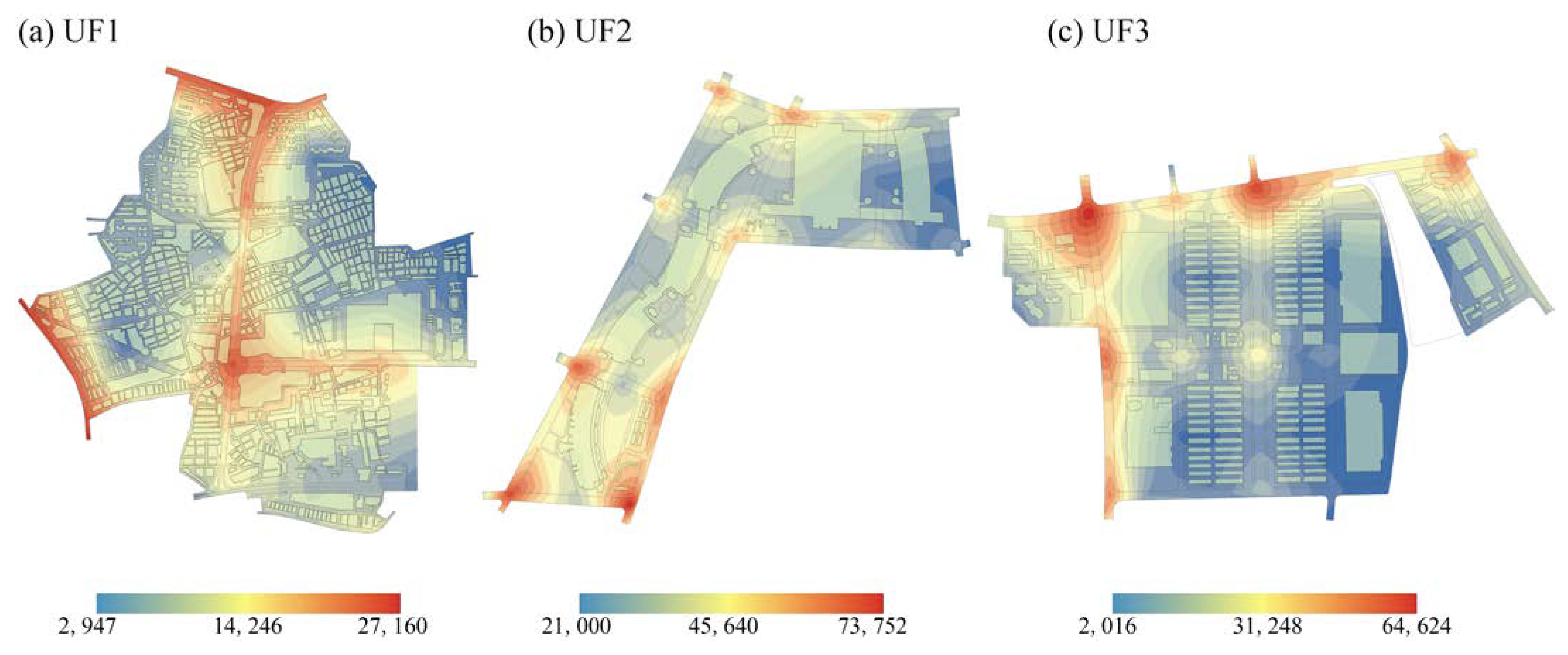

| Forms | Topology Graphics | Sample | Street Network(5 km Buffer) |
|---|---|---|---|
| Semilattice |  |  UF1, Guangzhou Zhongda |  |
| Lattice | 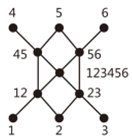 | 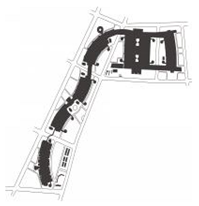 UF2, Yiwu Guoji Shangmao |  |
| Tree | 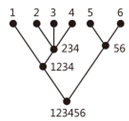 | 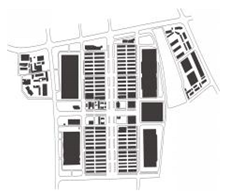 UF3, Shenzhen Huanan Cheng | 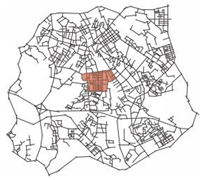 |
| Forms (Street Segments) | Metrics | Min | Max | Average | Std Dev | Median |
|---|---|---|---|---|---|---|
| UF1 (n = 145) | Mn | 2.471 | 6.155 | 4.282 | 0.734 | 4.313 |
| Dn | 0.901 | 3.162 | 1.491 | 0.363 | 1.427 | |
| Rn | 0.142 | 7.603 | 1.007 | 0.831 | 0.862 | |
| Cn | 1.000 | 27.00 | 3.642 | 2.643 | 3.000 | |
| UF2 (n = 123) | Mn | 2.601 | 6.932 | 4.231 | 0.713 | 4.414 |
| Dn | 0.757 | 2.752 | 1.441 | 0.335 | 1.412 | |
| Rn | 0.144 | 4.381 | 1.002 | 0.663 | 0.798 | |
| Cn | 1.000 | 18.000 | 3.891 | 2.312 | 3.000 | |
| UF3 (n = 84) | Mn | 2.021 | 4.872 | 3.014 | 0.492 | 3.015 |
| Dn | 1.012 | 3.813 | 2.054 | 0.525 | 1.962 | |
| Rn | 0.112 | 7.903 | 1.008 | 1.582 | 0.721 | |
| Cn | 1.000 | 31.000 | 5.471 | 5.752 | 4.000 |
| Forms | Metrics | Dn | Rn | Mn | Cn | Traffic Flow |
|---|---|---|---|---|---|---|
| UF1 | Dn | 1 | −0.884 ** | 0.973 *** | 0.994 ** | 0.407 |
| Rn | −0.884 ** | 1 | −0.949 ** | −0.907 ** | −0.109 | |
| Mn | 0.973 *** | −0.949 ** | 1 | 0.987 | 0.079 | |
| Cn | 0.994 ** | −0.907 ** | 0.987 | 1 | 0.062 | |
| Traffic Flow | 0.407 | −0.109 | 0.079 | 0.062 | 1 | |
| UF2 | Dn | 1 | 0.898 *** | −0.979 ** | 0.721 * | 0.510 |
| Rn | 0.898 *** | 1 | −0.406 | 0.900 ** | 0.344 | |
| Mn | −0.979 ** | −0.406 | 1 | −0.600 | −0.504 | |
| Cn | 0.721 * | 0.900 ** | −0.600 | 1 | 0.279 | |
| Traffic Flow | 0.510 | 0.344 | −0.504 | 0.279 | 1 | |
| UF3 | Dn | 1 | 0.783 * | −0.916 *** | 0.358 | 0.613 * |
| Rn | 0.783 * | 1 | 0.369 | 0.910 ** | −0.577 | |
| Mn | −0.916 *** | 0.369 | 1 | −0.451 | 0.112 | |
| Cn | 0.358 | 0.910 ** | −0.451 | 1 | −0.652 * | |
| Traffic Flow | 0.613 * | −0.577 | 0.112 | −0.652 * | 1 |
| Variable | Coefficient | Weight | p | Intercept | R2 | |
|---|---|---|---|---|---|---|
| UF1 | X1 | 17.617 | 4.273 | 0.001 | −14.428 | 0.880 |
| X2 | 2.236 | 2.703 | 0.017 | |||
| X3 | 3.051 | 3.517 | 0.003 | |||
| UF2 | X1 | 20.996 | 2.412 | 0.033 | 60.214 | 0.748 |
| X2 | 7.582 | 3.778 | 0.003 | |||
| X3 | 6.755 | 3.619 | 0.004 | |||
| UF3 | X1 | 36.155 | 2.316 | 0.033 | −35.590 | 0.834 |
| X2 | 4.372 | 2.385 | 0.280 | |||
| X3 | 5.085 | 3.698 | 0.002 |
Disclaimer/Publisher’s Note: The statements, opinions and data contained in all publications are solely those of the individual author(s) and contributor(s) and not of MDPI and/or the editor(s). MDPI and/or the editor(s) disclaim responsibility for any injury to people or property resulting from any ideas, methods, instructions or products referred to in the content. |
© 2023 by the authors. Licensee MDPI, Basel, Switzerland. This article is an open access article distributed under the terms and conditions of the Creative Commons Attribution (CC BY) license (https://creativecommons.org/licenses/by/4.0/).
Share and Cite
Zhou, W.; Guo, H.; Yao, L. Statistical Modeling of Traffic Flow in Commercial Clusters Based on a Street Network. Sustainability 2023, 15, 1832. https://doi.org/10.3390/su15031832
Zhou W, Guo H, Yao L. Statistical Modeling of Traffic Flow in Commercial Clusters Based on a Street Network. Sustainability. 2023; 15(3):1832. https://doi.org/10.3390/su15031832
Chicago/Turabian StyleZhou, Weiqiang, Haoxu Guo, and Lihao Yao. 2023. "Statistical Modeling of Traffic Flow in Commercial Clusters Based on a Street Network" Sustainability 15, no. 3: 1832. https://doi.org/10.3390/su15031832
APA StyleZhou, W., Guo, H., & Yao, L. (2023). Statistical Modeling of Traffic Flow in Commercial Clusters Based on a Street Network. Sustainability, 15(3), 1832. https://doi.org/10.3390/su15031832






